A mega trend in India’s savings – investment scenario is, the financialisation of savings and increasing preference for equity as an asset class for investment. Savings are moving away from real estate, gold and bank deposits and moving towards financial securities like equity, debt, mutual funds etc. Mutual funds (MFs) are becoming increasingly popular among investors. This financialisation of savings and increasing preference for equity as an asset class for investment appears to be a long-term structural trend. This article examines the major trends in the MF industry and its implications for investors.
The total MF Assets Under Management (AUM) in India, managed by 39 AMCs + 3 Infra debt AMCs stood at Rs.18.96 lakh crores as of 30 June 2017. Of which, the asset mix goes with 61% (Rs.11,47,464crs) in non-equity schemes and 39% (Rs.7,48,827 crs) in equity oriented schemes.
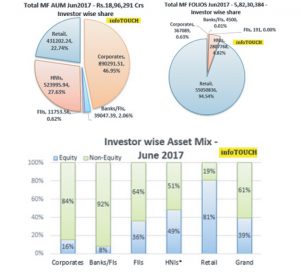
Investor-wise Asset Mix
Retail investors’ AUM remains focused mainly in equities with 81% invested in equity schemes. HNIs have 49% of their investments in equities. Corporates and banks held 84% and 92% of their assets, respectively, in non-equity schemes (Liquid, Debt, Gilt), as they park funds mainly for meeting their short to medium term liquidity needs.
Investor-wise AUM Share
According to the latest data by AMFI, 47% of the total MF AUM is with corporates, followed by 27.63% with HNIs, 22.74% with retail investors, 2.06% with banks and 0.62% with FIIs.
Retail investors account for 94.54 % of the total folios and HNIs account for 4.82%. According to AMFI, HNIs are those investing more than Rs.5 Lakhs.
Equity AUM Trends
Equity AUM has been steadily growing since Mar-2014, coinciding with the 2014 general elections leading to the formation of the new government. Since March 2014, total equity AUM has grown by a whopping 251%. Since June 2015, it has grown 82%. Retail investors’ AUM has seen a growth of 155% since Mar-2014, which is less than the overall growth. Interestingly HNIs equity AUM has witnessed a stunning growth of 440% since Mar-2014. See the following graphs.



Equity AUM – Investor-wise Share & holding period Trend
As on June 2017, equity AUM was around Rs.7.49 lakh crores. Of this, retail investors held 46.50%, followed by HNIs with 34% share. Corporates had a share of 18.6%. What is more noticeable is that out of the total equity AUM, 36.58% or Rs.2,73,917 crores are aged more than 2 years, that is, these assets are held for more than 2 years. Of this Equity AUM held for more than 2 years, 64% is held by retail investors and 26% by HNIs.\
It is a well-known fact that equity has the potential to deliver superior returns compared to other asset classes over a longer period of time. Indian mutual fund returns reinforce this truth.
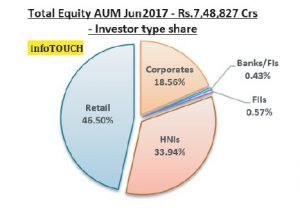
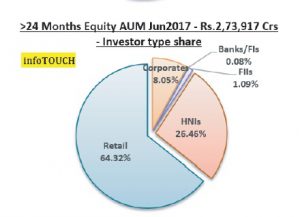
Equity AUM: analysis of holding period
Retail Investors: If we analyze the equity AUM based on holding period, as of June 2017, out of retail investor’s equity AUM (Rs.3,48,216 crs), 31.75% is less than 12 months old (highest since 2009), and 50.6% are more than 2 years old. The share of AUM held for more than 2 years has been gradually coming down since Dec-2014 and it is at lowest point since 2009, according to AMFI data.
HNI Investors: Out of HNI’s equity AUM (Rs.2,54,158crs), 52.61% is less than 12 months old (very new AUM) and 28.5% of AUM is held for more than 2 years as of June 2017. This has improved though, after hitting a low of 22% in Sep-2015.
On the other hand, out of FII’s equity AUM, 70% are more than 2 years old.
Drop in the share of >24 months AUM could possibly happen because of 2 major reasons.
One, this may be due to the relative increase in new AUM (<12 Months) from new investors and fresh investment by existing investors. This is a healthy trend. In the recent past, the industry has witnessed steady monthly net Inflows, and better growth in folios and AUM. At the same time, redemptions had a steep rise as of Jun-2017.
Secondly, the new AUM (<12 months) is going up because the existing investors redeem their investments in short-term and might be reinvesting again, either fully or partially, along with new investors. This would still increase the inflow and short-term AUM. If the reduction of long term AUM’s share is due to short-term churn by the existing investors, then it is a cause of worry, since such investors will stand to lose the benefits of long-term returns. It will also significantly increase the ‘timing risk’ for investors in the markets. Here, the AUM appears new, but it is a recycled investment and they hardly gain in the long-term.
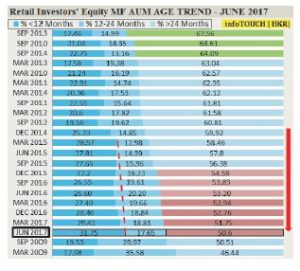

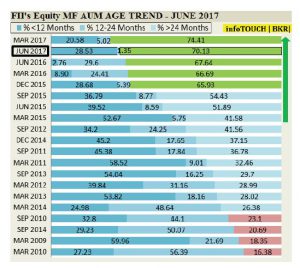
It must be pointed here that at times, long-term AUM would carry a higher component of market gains as compared to a new AUM. Between June 2015 and June 2017, Equity+Balanced category retail investor’s folio rose 34% whereas AUM went up 67%. Retail investor total equity AUM rose70% whereas AUMs held for more than 24 months rose only 49%.
If we extrapolate the rate at which equity AUM holding period is dropping, say for 5 or 10 years, then the actual number of long-term investors would come down still further. On one side, there is a good growth in inflows and addition of folios. But on the other side, investments are churned in the short-term, which is an unhealthy trend.
Going by the data available, as of Jun 2017, we have around 128 open-ended equity-oriented schemes that have an age of 10+ years and have an AUM in excess of Rs.500 Crs. The average CAGR delivered by these schemes was around 12.13%. It is possible for an investor to enjoy these attractive long-term returns, only if they had stayed invested for long, unperturbed by market volatility. There are many equity diversified funds that have delivered CAGR of more than 15 % over 20 years. When we consider the fact that dividends from equity and balanced funds and long-term capital gains are tax free, these are excellent returns.
Since 2014, with some intermittent volatility influenced by various factors – domestic and global – broad indices have been recording new highs (as of July-2017). While investors were overall happy with this rise, every new high also tempts investors to book profits. Those who hold their long-term goals and vision tight and remain invested for long, reap substantial gains.
Investors often try to time the markets, especially when it is at a high, by redeeming and waiting for a re-entry opportunity on market correction. It is well known that ‘timing the market’ is almost an impossible task. Instead it is ‘the time in the market’ that works better in the long run. Investors should understand this fundamental principle of investment in equity. As India grows from a $ 2.2 trillion economy presently to an estimated $ 10 trillion economy by 2030, phenomenal wealth will be created through the capital market. If investors are to benefit from this enormous potential wealth creation, they should spend a lot of ‘time in the market.’ In other words, be a disciplined, systematic long-term investor.
Data Source: AMFI. Internal research compilation.
By Sriram BKR










